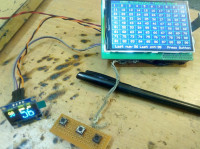Tambola / Housie on Arduino

Hi,Here's a complete project of a gambling game called Tambola (also called housie or Bingo! game in US & UK) on UNO. It's very popular here in India.The game requires lots of hardware for creating the random number generation which is replaced by Arduino UNO with a big 4" display (ILI9488).
Hi,
Here's a complete project of a gambling game called Tambola (also called housie or Bingo! game in US & UK) on UNO. It's very popular here in India.
The game requires lots of hardware for creating the random number generation which is replaced by Arduino UNO with a big 4" display (ILI9488).
It has one push button to create the random number generation while one more button is used for resetting the game. For resetting both the buttons to be pressed together.
Two small 256 Byte EEPROM -24LC256 is used on I2C bus for safe storing of data in case of power failure. Operating voltage is 3.3 @ 150 mA.
To make the button press audible I've provided a PWM tone into the software.
For random number generation I've used this way - First it senses the stray induction at one of the analog pin A0 (that's in the range of 0 to 1023 ) it is then used to create the randomSeed generation. After that random(number) is used.
val=analogRead(A0);
randomSeed(val);
rand1 = random(number);
This way it ensures that everytime it gets a new set of random number creation.
The BOM is as follows.
4" ILI9488 display from aliexpress.com = $8
Arduino UNO made on ATMEGA328 on board =$4
2 no 24LC256 = $3
64*128 1.8" OLED= $4
wires, speaker,push buttons,resistors=$5
--------------------------------------------------------------------
Total = $29
--------------------------------------------------------------------
The code is complete. Soon I'm going upload the schematic and the Arduino sketch.
The ILI-9488 (26 pin) connection with Arduino is shown here.
https://drive.google.com/file/d/0B3E3LcSKoM-6dEFGUGNWUHg3eVE/view?usp=sharing
The Arduino sketch for Tambola game is here.
https://drive.google.com/file/d/0B3E3LcSKoM-6XzN4SlJyZmhtRUE/view?usp=sharing
28/02/16
In the real housie game today the audience wanted to know what is actually happening on the board. Therefore, I've added a second OLED display here which will be facing the audience always, showing the round number and the number.
The Arduino sketch for Tambola with OLED is here.
https://drive.google.com/file/d/0B3E3LcSKoM-6VS1lUWdPTWxsa0k/view?usp=sharing
Finally the Tambola schematic is here with OLED connection
https://drive.google.com/file/d/0B3E3LcSKoM-6d3pwN21KdzBmMXc/view?usp=sharing
Bera S
Vindhyanagar



Discussie (3 opmerking(en))